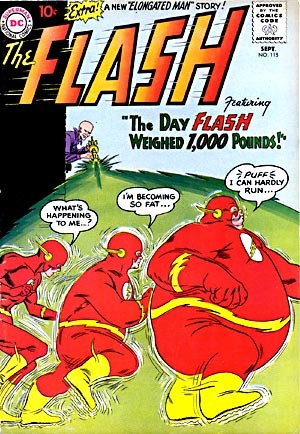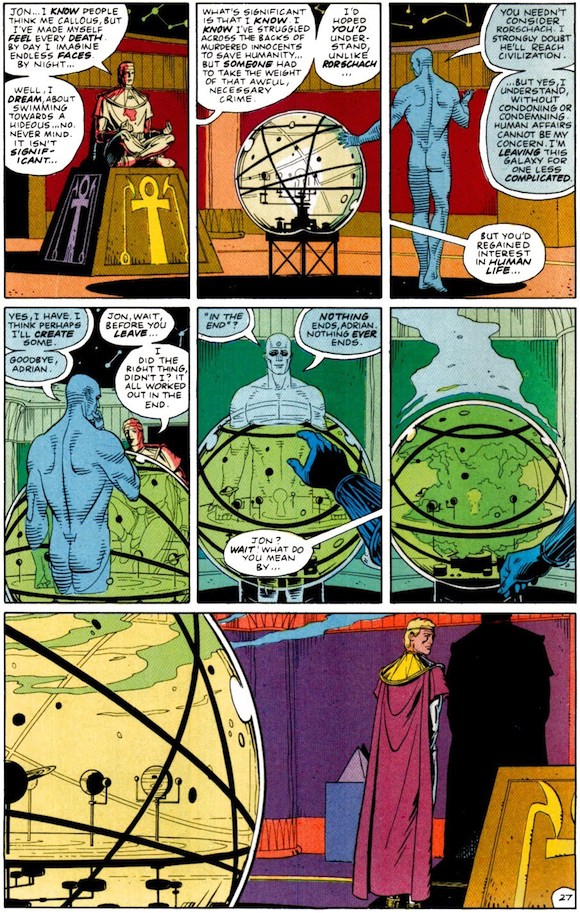This first appeared on comixology.
___________
The above is Reptiles, a lithograph print from 1943 by the famous Dutch artist M.C. Escher. Escher isn’t usually thought of as a comics artist. Yet, as this image shows, he was one — sort of.
So is this print a comic or not? Well, it depends on how you read it. The narrative here determines the form.
Do you see this as the story of a bunch of different reptiles crawling in single file out of an abstract design, over books and other objects, and back into the design? If so, then it’s a static illustration — a drawing of one moment in time.
On the other hand…do you see this as the story of a single reptile, depicted in various stages as it makes its journey from art to life and back again? If so then, despite the lack of panels, this is essentially a comic. It’s not a frozen moment, but a sequence.
Of course, you don’t really need to make a choice for one or the other. The title of the piece may indicate that there are a bunch of reptiles here, but much of the enjoyment of the image — and of Escher’s work in general — is the sense of moving pieces caught in a pleasurably regimented dance. Even if it’s not technically one reptile moving, the individuals are nonetheless interchangeable. You know that the reptile climbing the triangle is going to get to the top of the D & D die and that it’s going to blow smoke out of its nose when it gets there just as its predecessor did. The reptile blowing smoke will climb onto the little cup; the reptile on the cup will crawl back into the abstract pattern. Whether the image is showing a sequence as a comic would or merely implying it, the point is still that time and identity are flattened out across space.
Escher is hardly the only comics artist to use this sort of trick. Here’s a familiar example from Carmine Infantino.
A more sophisticated use of the trope can be found in Alan Moore and Dave Gibbons’ Watchmen. In that book, the character of Dr. Manhattan (Jon Ostermann) is essentially an Escher lizard who has achieved self-awareness. He knows that time is a pattern, and (like the observer of the print) he can see that pattern all at once, from the moment he crawls up out of the flat drawing to the moment he crawls back into it. His lifetime is a clockwork puzzle, unchangeable and simultaneous. Sequence and stillness fuse, and in doing so call into question both free will and identity.
In the panel above, Moore and Gibbons emphasize Jon’s disjunction in time by giving him two bodies in the same space. Laurie’s shocked reaction points out the weirdness of her big blue boyfriend — but it also comments on the weirdness of the way in which comics depicts sequence. After all, there are many pages of Watchmen in which you see two Manhattans side by side, or one on top of the other.
The difference between the first example and the second is not how many bodies (there’s more than one Manhattan in the second, too) but our perception of those bodies — not how many lizards are drawn, but whether we’ve decided to see them as a group or a sequence. Laurie is horrified when she wakes up in bed with double Jons because she’s suddenly allowed to view the world as Jon sees it — not as one body walking through time, but as multiple bodies in the same space. Her pleasure depends on not seeing the pattern.
Moore and Gibbons use the play of sequence and simultaneity to investigate comics form. But they also use it to look at how time and the perception of time affects human decisions and identity. Reptiles has more limited ambitions. Like most of Escher’s work, it’s clearly a goof, more in play than in earnest, posing frivolous questions (what kind of lizards are those? what’s in the book?) for the fun of it rather than for some profounder understanding.
And yet, the shallowness of Escher’s drawing is surely the point. Time becomes space when you flatten both out, but where can you go that isn’t flat? Laurie’s fright upon seeing the mechanics of narrative laid bare is itself part of the narrative, just as the lizards climbing up out of the page are still on the page. For those small animals, narrative is not a series of events; it has no starting point or ending point. Instead, it’s a cycle of greater and lesser abstraction; of flattening and inflating. Identity is the design of time dividing from itself; the only story is of story pulling itself from pattern and returning to it. Even the blue lizard watching lizards remains only the sketch of a lizard.
What makes Reptiles a comic, then, is the way that it crawls so determinedly betwixt and between the intriguing silence of those books and the flat silence of that pattern. If narrative is time and picture is space, these critters move through both and neither; they’re more amphibian than reptile. If they could talk, they might tell us not what it is to see all of time as a page, but rather what it is to be a surface — a space so thin it cannot tell whether it exists or not.




